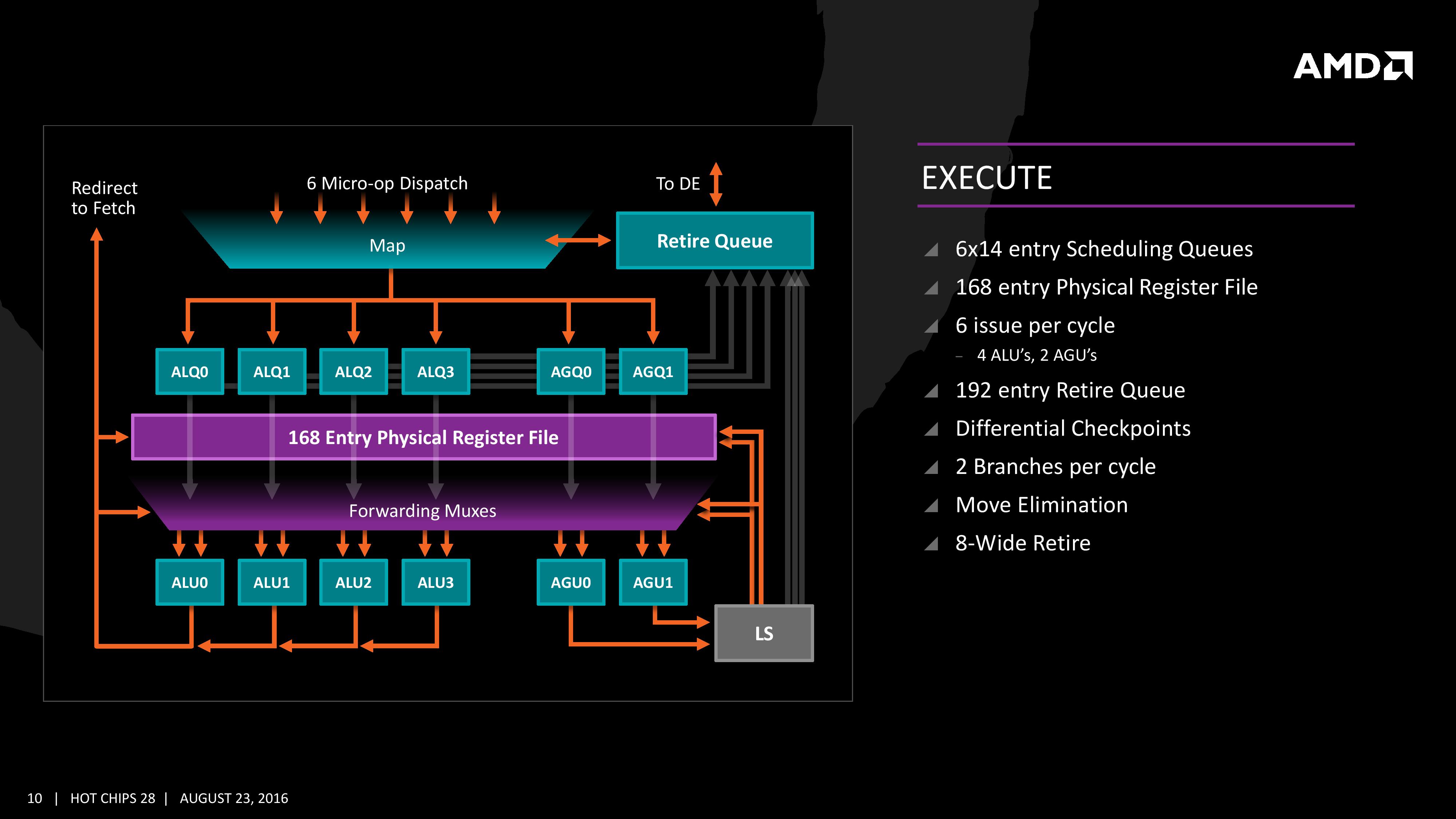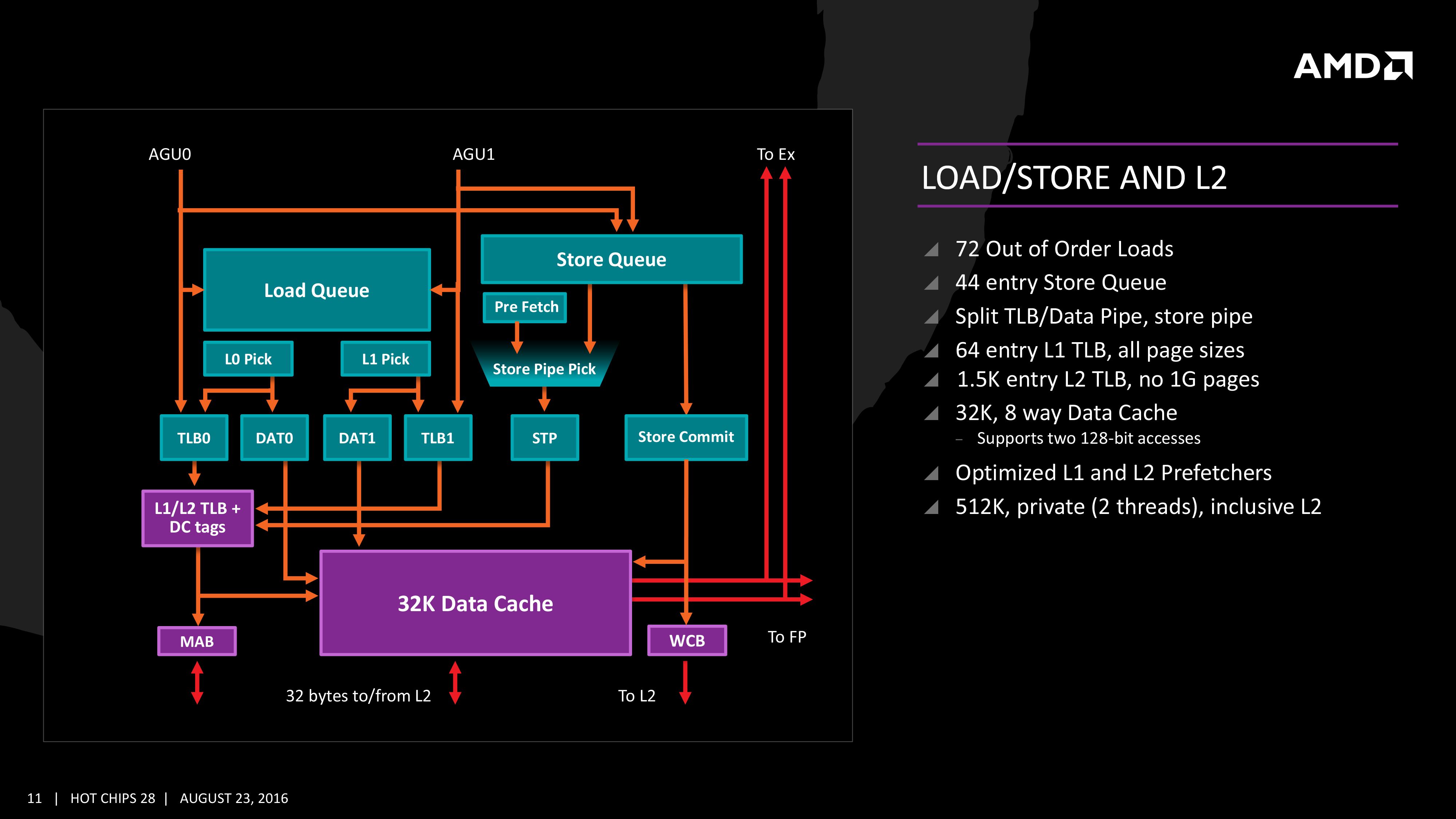The AMD Zen and Ryzen 7 Review: A Deep Dive on 1800X, 1700X and 1700
by Ian Cutress on March 2, 2017 9:00 AM ESTExecution, Load/Store, INT and FP Scheduling
The execution of micro-ops get filters into the Integer (INT) and Floating Point (FP) parts of the core, which each have different pipes and execution ports. First up is the Integer pipe which affords a 168-entry register file which forwards into four arithmetic logic units and two address generation units. This allows the core to schedule six micro-ops/cycle, and each execution port has its own 14-entry schedule queue.
The INT unit can work on two branches per cycle, but it should be noted that not all the ALUs are equal. Only two ALUs are capable of branches, one of the ALUs can perform IMUL operations (signed multiply), and only one can do CRC operations. There are other limitations as well, but broadly we are told that the ALUs are symmetric except for a few focused operations. Exactly what operations will be disclosed closer to the launch date.
The INT pipe will keep track of branching instructions with differential checkpoints, to cut down on storing redundant data between branches (saves queue entries and power), but can also perform Move Elimination. This is where a simple mov command between two registers occurs – instead of inflicting a high energy loop around the core to physically move the single instruction, the core adjusts the pointers to the registers instead and essentially applies a new mapping table, which is a lower power operation.
Both INT and FP units have direct access to the retire queue, which is 192-entry and can retire 8 instructions per cycle. In some previous x86 CPU designs, the retire unit was a limiting factor for extracting peak performance, and so having it retire quicker than dispatch should keep the queue relatively empty and not near the limit.
The Load/Store Units are accessible from both AGUs simultaneously, and will support 72 out-of-order loads. Overall, as mentioned before, the core can perform two 16B loads (2x128-bit) and one 16B store per cycle, with the latter relying on a 44-entry Store queue. The TLB buffer for the L2 cache for already decoded addresses is two level here, with the L1 TLB supporting 64-entry at all page sizes and the L2 TLB going for 1.5K-entry with no 1G pages. The TLB and data pipes are split in this design, which relies on tags to determine if the data is in the cache or to start the data prefetch earlier in the pipeline.
The data cache here also has direct access to the main L2 cache at 32 Bytes/cycle, with the 512 KB 8-way L2 cache being private to the core and inclusive. When data resides back in L1 it can be processed back to either the INT or the FP pipes as required.
Moving onto the floating point part of the core, and the first thing to notice is that there are two scheduling queues here. These are listed as ‘schedulable’ and ‘non-schedulable’ queues with lower power operation when certain micro-ops are in play, but also allows the backup queue to sort out parts of the dispatch in advance via the LDCVT. The register file is 160 entry, with direct FP to INT transfers as required, as well as supporting accelerated recovery on flushes (when data is written to a cache further back in the hierarchy to make room).
The FP Unit uses four pipes rather than three on Excavator, and we are told that the latency in Zen is reduced as well for operations (though more information on this will come at a later date). We have two MUL and two ADD in the FP unit, capable of joining to form two 128-bit FMACs, but not one 256-bit AVX. In order to do AVX, the unit will split the operations accordingly. On the counter side each core will have 2 AES units for cryptography as well as decode support for SSE, AVX1/2, SHA and legacy mmx/x87 compliant code.













574 Comments
View All Comments
Cooe - Sunday, February 28, 2021 - link
Absolute nonsense. Game code is optimized specifically for the Intel Core pipeline & ESPECIALLY it's ring bus interconnect. There's no such thing as "optimizing for x86". Code is either written with the x86 ISA or its not...FriendlyUser - Thursday, March 2, 2017 - link
The 1700X with a premium motherboard is cheaper and faster than the 6850K. If you absolutely need the extra PCIe lanes or the 8 DIMM slots, then x99 is better, otherwise you are getting less perf/$.mapesdhs - Thursday, March 2, 2017 - link
Or a used X79. I'm still rather surprised how close my 3930K/4.8 results are to the tests results shown here (CB10/ST = 7935, CB10/MT = 42389 , CB11.5/MT = 13.80, CB R15 MT = 1241). People are selling used 3930Ks for as little as 80 UKP now, though finding a decent mbd is a bit more tricky.I have an ASUS R5E/6850K setup to test, alongside a used-parts ASYS P9X79-E WS/4960X which cost scarily less than the new X99 setup, it'll be interesting to see how these behave against the KL/BW-E/Ryzen numbers shown here.
Ian.
Aerodrifting - Thursday, March 2, 2017 - link
"$500 1800x is still too expensive. According to this even a 7700k @ $300 -$350 is still a good choice for gamers."Same thing can be said for every Intel extreme platform processors, $1000 5960X/6900K is still too expensive, $1600 6950X is too expensive, Because 7700K is better for gaming.
Then you said "2011-v3 still offers a platform with more PCIe3 lanes and quad memory channel. ", Which directly contradict what you said earlier about gaming, How does more PCIe3 lanes and quad channel memory improve your FPS when video cards run fine with x8.
Your are too idiotic to even run coherent argument.
lmcd - Thursday, March 2, 2017 - link
What on earth are you talking about? PCIe3 lanes and quad channel memory are helpful for prosumer workloads. It's not contradictory at all?mapesdhs - Thursday, March 2, 2017 - link
Yup, quad GPU for After Effects RT3D, and fast RAM makes quite a difference.Notmyusualid - Friday, March 3, 2017 - link
@mapesdhs:Indeed.
Also, I can actually 'feel' the difference going from dual to quad channel ram performance.
I checked, and I hadn't correctly seated one of my four 16GB modules...
Shutdown, reseat, reboot, and it 'felt' faster again.
Aerodrifting - Thursday, March 2, 2017 - link
Learn to read a complete sentence please."nos024" was complaining gaming performance, Then he pulled out extra PCIe3 lanes and quad channel memory to defend X99 platform even though they were also inferior to 7700K in gaming (just like Ryzen). That makes him sound like a completely moron, Because games don't care about those extra PCIe lane or quad channel memory.
Notmyusualid - Friday, March 3, 2017 - link
X99 'inferior'?I just popped over the 3dmark11's results page, selected GPU as 1080, and I had to scroll down to 199th place (a 7700k clocked to a likely LN2 5.8GHz), to find a system that wasn't triple, or quad channel equipped.
Here: http://www.3dmark.com/search#/?url=/proxycon/ajax/...
So I guess those lanes don't help us multip-gpu people after all?
Swallow.
Aerodrifting - Saturday, March 4, 2017 - link
Because 3Dmark11 hall of fame ranking equals real life gaming performance.Are you a moron or just trolling? Everyone knows when it comes to gaming, A high frequency i7 (such as 7700K) beats everything else, Including 8 core Ryzen or 10 core i7 extreme 6950X.